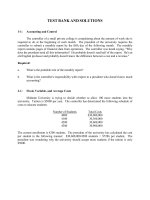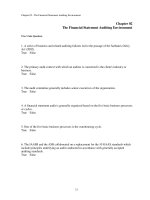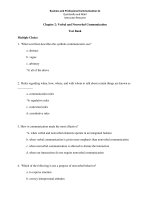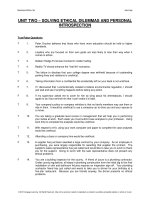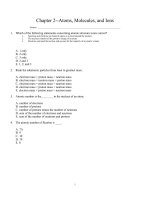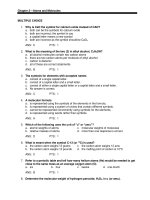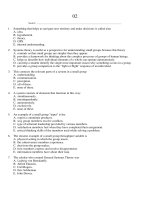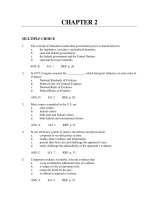Quality and performance excellence 8th edition evans test bank
Bạn đang xem bản rút gọn của tài liệu. Xem và tải ngay bản đầy đủ của tài liệu tại đây (145.2 KB, 25 trang )
CHAPTER 02—Frameworks for Quality and Performance Excellence
1. Deming provided a clear and precise definition of quality.
a. True
b. False
ANSWER:
False
DIFFICULTY:
Difficulty: Easy
ACCREDITING STANDARDS: BUSPROG: Analytic
DISC: Operations Management
TOPICS:
DESC.EVAL.17.02.01 Foundations of Performance Excellence
KEYWORDS:
Bloom's: Knowledge
2. According to Deming’s philosophy, a bad batch of material purchased from a supplier is an example of a common
cause of variation.
a. True
b. False
ANSWER:
False
DIFFICULTY:
Difficulty: Easy
ACCREDITING STANDARDS: BUSPROG: Analytic
DISC: Operations Management
TOPICS:
DESC.EVAL.17.02.01 Foundations of Performance Excellence
KEYWORDS:
Bloom's: Knowledge
3. A system governed only by common causes is stable and its performance can be predicted.
a. True
b. False
ANSWER:
True
DIFFICULTY:
Difficulty: Easy
ACCREDITING STANDARDS: BUSPROG: Analytic
DISC: Operations Management
TOPICS:
DESC.EVAL.17.02.01 Foundations of Performance Excellence
KEYWORDS:
Bloom's: Knowledge
4. Special causes disrupt the predictable pattern of a system.
a. True
b. False
ANSWER:
True
DIFFICULTY:
Difficulty: Easy
ACCREDITING STANDARDS: BUSPROG: Analytic
DISC: Operations Management
TOPICS:
DESC.EVAL.17.02.01 Foundations of Performance Excellence
KEYWORDS:
Bloom's: Knowledge
Cengage Learning Testing, Powered by Cognero
Page 1
CHAPTER 02—Frameworks for Quality and Performance Excellence
5. In Deming’s view, variation is the chief culprit of poor quality.
a. True
b. False
ANSWER:
True
DIFFICULTY:
Difficulty: Easy
ACCREDITING STANDARDS: BUSPROG: Analytic
DISC: Operations Management
TOPICS:
DESC.EVAL.17.02.01 Foundations of Performance Excellence
KEYWORDS:
Bloom's: Knowledge
6. Juran advocates the accounting and analysis of quality costs to focus attention on quality problems.
a. True
b. False
ANSWER:
True
DIFFICULTY:
Difficulty: Easy
ACCREDITING STANDARDS: BUSPROG: Analytic
DISC: Operations Management
TOPICS:
DESC.EVAL.17.02.01 Foundations of Performance Excellence
KEYWORDS:
Bloom's: Knowledge
7. According to Crosby’s Absolutes of Quality Management, quality means conformance to elegance, not
requirements.
a. True
b. False
ANSWER:
False
DIFFICULTY:
Difficulty: Easy
ACCREDITING STANDARDS: BUSPROG: Analytic
DISC: Operations Management
TOPICS:
DESC.EVAL.17.02.01 Foundations of Performance Excellence
KEYWORDS:
Bloom's: Knowledge
8. Crosby placed more emphasis on management and organizational processes for changing corporate culture and
attitudes than on the use of statistical techniques.
a. True
b. False
ANSWER:
True
DIFFICULTY:
Difficulty: Easy
ACCREDITING STANDARDS: BUSPROG: Analytic
DISC: Operations Management
TOPICS:
DESC.EVAL.17.02.01 Foundations of Performance Excellence
KEYWORDS:
Bloom's: Knowledge
Cengage Learning Testing, Powered by Cognero
Page 2
CHAPTER 02—Frameworks for Quality and Performance Excellence
9. The Deming Award recognizes U.S. companies that excel in quality management practice and performance.
a. True
b. False
ANSWER:
False
DIFFICULTY:
Difficulty: Easy
ACCREDITING STANDARDS: BUSPROG: Analytic
DISC: Operations Management
TOPICS:
DESC.EVAL.17.02.02 The Baldrige Award
KEYWORDS:
Bloom's: Knowledge
10. The Baldrige Criteria for performance excellence consist of a non-hierarchical set of categories, items, and areas to
address.
a. True
b. False
ANSWER:
False
DIFFICULTY:
Difficulty: Easy
ACCREDITING STANDARDS: BUSPROG: Analytic
DISC: Operations Management
TOPICS:
DESC.EVAL.17.02.02 The Baldrige Award
KEYWORDS:
Bloom's: Knowledge
11. In the Baldrige award evaluation process, to help examiners understand the context of the organization, applicants
are required to provide a Performance Profile, which is basically a snapshot of the organization that describes the
organizational environment.
a. True
b. False
ANSWER:
False
DIFFICULTY:
Difficulty: Easy
ACCREDITING STANDARDS: BUSPROG: Analytic
DISC: Operations Management
TOPICS:
DESC.EVAL.17.02.02 The Baldrige Award
KEYWORDS:
Bloom's: Knowledge
12. Deployment refers to the extent to which an approach is applied to all requirements of the item.
a. True
b. False
ANSWER:
True
DIFFICULTY:
Difficulty: Easy
ACCREDITING STANDARDS: BUSPROG: Analytic
DISC: Operations Management
TOPICS:
DESC.EVAL.17.02.02 The Baldrige Award
KEYWORDS:
Bloom's: Knowledge
Cengage Learning Testing, Powered by Cognero
Page 3
CHAPTER 02—Frameworks for Quality and Performance Excellence
13. Sustainability refers to an organization’s ability to address current business needs and to have the agility and strategic
management to prepare successfully for the future.
a. True
b. False
ANSWER:
True
DIFFICULTY:
Difficulty: Easy
ACCREDITING STANDARDS: BUSPROG: Analytic
DISC: Operations Management
TOPICS:
DESC.EVAL.17.02.02 The Baldrige Award
KEYWORDS:
Bloom's: Knowledge
14. The 10 major categories of the Deming prize are further divided into “checking points.”
a. True
b. False
ANSWER:
True
DIFFICULTY:
Difficulty: Easy
ACCREDITING STANDARDS: BUSPROG: Analytic
DISC: Operations Management
TOPICS:
DESC.EVAL.17.02.03 International Quality and Performance Excellence Award
Programs
KEYWORDS:
Bloom's: Knowledge
15. For companies that apply for the Deming prize but do not qualify, the examination process is automatically extended
up to two times over three years.
a. True
b. False
ANSWER:
True
DIFFICULTY:
Difficulty: Easy
ACCREDITING STANDARDS: BUSPROG: Analytic
DISC: Operations Management
TOPICS:
DESC.EVAL.17.02.03 International Quality and Performance Excellence Award
Programs
KEYWORDS:
Bloom's: Knowledge
Cengage Learning Testing, Powered by Cognero
Page 4
CHAPTER 02—Frameworks for Quality and Performance Excellence
16. In the additional awards given by the European Foundation for Quality Management, Recognized for Excellence is
given for organizations that are at the beginning of the journey to excellence.
a. True
b. False
ANSWER:
False
DIFFICULTY:
Difficulty: Easy
ACCREDITING STANDARDS: BUSPROG: Analytic
DISC: Operations Management
TOPICS:
DESC.EVAL.17.02.03 International Quality and Performance Excellence Award
Programs
KEYWORDS:
Bloom's: Knowledge
17. Enablers are the means by which an organization approaches its business responsibilities.
a. True
b. False
ANSWER:
True
DIFFICULTY:
Difficulty: Easy
ACCREDITING STANDARDS: BUSPROG: Analytic
DISC: Operations Management
TOPICS:
DESC.EVAL.17.02.03 International Quality and Performance Excellence Award
Programs
KEYWORDS:
Bloom's: Knowledge
18. The American National Standards Institute (ANSI) has adopted ISO standards in the United States.
a. True
b. False
ANSWER:
True
DIFFICULTY:
Difficulty: Easy
ACCREDITING STANDARDS: BUSPROG: Analytic
DISC: Operations Management
TOPICS:
DESC.EVAL.17.02.04 ISO 9000:2000
KEYWORDS:
Bloom's: Knowledge
19. The ISO 9004:2009 document includes the fundamentals and vocabulary of the ISO standards.
a. True
b. False
ANSWER:
False
DIFFICULTY:
Difficulty: Easy
ACCREDITING STANDARDS: BUSPROG: Analytic
DISC: Operations Management
TOPICS:
DESC.EVAL.17.02.04 ISO 9000:2000
KEYWORDS:
Bloom's: Knowledge
Cengage Learning Testing, Powered by Cognero
Page 5
CHAPTER 02—Frameworks for Quality and Performance Excellence
20. ISO 9001:2008 provides a structure for a basic QMS and is intended to demonstrate compliance with recognized
quality principles to customers and for third-party certification.
a. True
b. False
ANSWER:
True
DIFFICULTY:
Difficulty: Easy
ACCREDITING STANDARDS: BUSPROG: Analytic
DISC: Operations Management
TOPICS:
DESC.EVAL.17.02.04 ISO 9000:2000
KEYWORDS:
Bloom's: Knowledge
21. The concept of Six Sigma is facilitated through use of basic and advanced quality improvement and control tools by
teams whose members are trained to provide fact-based decision-making information.
a. True
b. False
ANSWER:
True
DIFFICULTY:
Difficulty: Easy
ACCREDITING STANDARDS: BUSPROG: Analytic
DISC: Operations Management
TOPICS:
DESC.EVAL.17.02.05 Six Sigma
KEYWORDS:
Bloom's: Knowledge
22. The origin of the term Six Sigma came from a statistical measure that equates to 6.4 or fewer errors or defects per
million opportunities.
a. True
b. False
ANSWER:
False
DIFFICULTY:
Difficulty: Easy
ACCREDITING STANDARDS: BUSPROG: Analytic
DISC: Operations Management
TOPICS:
DESC.EVAL.17.02.05 Six Sigma
KEYWORDS:
Bloom's: Knowledge
23. Google pioneered the concept of Six Sigma as an approach to measuring product and service quality.
a. True
b. False
ANSWER:
False
DIFFICULTY:
Difficulty: Easy
ACCREDITING STANDARDS: BUSPROG: Analytic
DISC: Operations Management
TOPICS:
DESC.EVAL.17.02.05 Six Sigma
KEYWORDS:
Bloom's: Knowledge
Cengage Learning Testing, Powered by Cognero
Page 6
CHAPTER 02—Frameworks for Quality and Performance Excellence
24. Six Sigma is based largely on worker empowerment and teams; TQ is owned by business leader champions.
a. True
b. False
ANSWER:
False
DIFFICULTY:
Difficulty: Easy
ACCREDITING STANDARDS: BUSPROG: Analytic
DISC: Operations Management
TOPICS:
DESC.EVAL.17.02.05 Six Sigma
KEYWORDS:
Bloom's: Knowledge
25. Six Sigma applies to manufacturing processes as well as to services.
a. True
b. False
ANSWER:
True
DIFFICULTY:
Difficulty: Easy
ACCREDITING STANDARDS: BUSPROG: Analytic
DISC: Operations Management
TOPICS:
DESC.EVAL.17.02.05 Six Sigma
KEYWORDS:
Bloom's: Knowledge
26. TQ activities generally occur within a function, process, or individual workplace; Six Sigma projects are truly crossfunctional.
a. True
b. False
ANSWER:
True
DIFFICULTY:
Difficulty: Easy
ACCREDITING STANDARDS: BUSPROG: Analytic
DISC: Operations Management
TOPICS:
DESC.EVAL.17.02.05 Six Sigma
KEYWORDS:
Bloom's: Knowledge
27. The Baldrige Criteria for Performance Excellence focuses on product and service conformity for guaranteeing
equity in the marketplace and concentrates on fixing quality system problems and product and service
nonconformities.
a. True
b. False
ANSWER:
False
DIFFICULTY:
Difficulty: Easy
ACCREDITING STANDARDS: BUSPROG: Analytic
DISC: Operations Management
TOPICS:
DESC.EVAL.17.02.06 Comparing Baldrige, ISO 9000, and Six Sigma
KEYWORDS:
Bloom's: Knowledge
Cengage Learning Testing, Powered by Cognero
Page 7
CHAPTER 02—Frameworks for Quality and Performance Excellence
28. ISO 9000 focuses on performance excellence for the entire organization in an overall management framework.
a. True
b. False
ANSWER:
False
DIFFICULTY:
Difficulty: Easy
ACCREDITING STANDARDS: BUSPROG: Analytic
DISC: Operations Management
TOPICS:
DESC.EVAL.17.02.06 Comparing Baldrige, ISO 9000, and Six Sigma
KEYWORDS:
Bloom's: Knowledge
29. Although the 2000 revision of ISO 9000 incorporated many of the Baldrige criteria’s original principles, it still is not a
comprehensive business performance framework.
a. True
b. False
ANSWER:
True
DIFFICULTY:
Difficulty: Easy
ACCREDITING STANDARDS: BUSPROG: Analytic
DISC: Operations Management
TOPICS:
DESC.EVAL.17.02.06 Comparing Baldrige, ISO 9000, and Six Sigma
KEYWORDS:
Bloom's: Knowledge
30. Six Sigma involves periodic review of Six Sigma plans and projects, providing champions to sponsor projects,
providing training resources, and communicating progress and achievements.
a. True
b. False
ANSWER:
True
DIFFICULTY:
Difficulty: Easy
ACCREDITING STANDARDS: BUSPROG: Analytic
DISC: Operations Management
TOPICS:
DESC.EVAL.17.02.06 Comparing Baldrige, ISO 9000, and Six Sigma
KEYWORDS:
Bloom's: Knowledge
Cengage Learning Testing, Powered by Cognero
Page 8
CHAPTER 02—Frameworks for Quality and Performance Excellence
31. Deming summarized his philosophy of quality and management in what he called _____.
a. steps to total quality.
b. basic elements of improvement.
c. absolutes of quality management.
d. a system of profound knowledge.
ANSWER:
d
DIFFICULTY:
Difficulty: Easy
ACCREDITING STANDARDS: BUSPROG: Analytic
DISC: Operations Management
TOPICS:
DESC.EVAL.17.02.01 Foundations of Performance Excellence
KEYWORDS:
Bloom's: Knowledge
32. Deming emphasized that management’s job is to:
a. increase process variance.
b. control the process indexes.
c. optimize the system.
d. give orders and punishments.
ANSWER:
c
DIFFICULTY:
Difficulty: Easy
ACCREDITING STANDARDS: BUSPROG: Analytic
DISC: Operational Management
TOPICS:
DESC.EVAL.17.02.01 Foundations of Performance Excellence
KEYWORDS:
Bloom's: Knowledge
33. According to Deming, factors causing variation that are present as a natural part of a process are called:
a. common causes of variation.
b. total variances.
c. assignable causes of variation.
d. system variances.
ANSWER:
a
DIFFICULTY:
Difficulty: Easy
ACCREDITING STANDARDS: BUSPROG: Analytic
DISC: Operations Management
TOPICS:
DESC.EVAL.17.02.01 Foundations of Performance Excellence
KEYWORDS:
Bloom's: Knowledge
Cengage Learning Testing, Powered by Cognero
Page 9
CHAPTER 02—Frameworks for Quality and Performance Excellence
34. Variations that result from special causes are called:
a. common variances.
b. random variances.
c. assignable causes.
d. secondary causes of variation.
ANSWER:
c
DIFFICULTY:
Difficulty: Easy
ACCREDITING STANDARDS: BUSPROG: Analytic
DISC: Operations Management
TOPICS:
DESC.EVAL.17.02.01 Foundations of Performance Excellence
KEYWORDS:
Bloom's: Knowledge
35. _____ causes of variation arise from external sources that are not inherent in the process.
a. Special
b. Unassignable
c. Common
d. Non-system
ANSWER:
a
DIFFICULTY:
Difficulty: Easy
ACCREDITING STANDARDS: BUSPROG: Analytic
DISC: Operations Management
TOPICS:
DESC.EVAL.17.02.01 Foundations of Performance Excellence
KEYWORDS:
Bloom's: Knowledge
36. A system governed only by _____ causes is stable and its performance can be predicted.
a. special
b. unique
c. common
d. assignable
ANSWER:
c
DIFFICULTY:
Difficulty: Easy
ACCREDITING STANDARDS: BUSPROG: Analytic
DISC: Operations Management
TOPICS:
DESC.EVAL.17.02.01 Foundations of Performance Excellence
KEYWORDS:
Bloom's: Knowledge
Cengage Learning Testing, Powered by Cognero
Page 10
CHAPTER 02—Frameworks for Quality and Performance Excellence
37. Which of the following is an example of a common cause of variation in a manufacturing process?
a. Miscalibration of measuring instruments
b. A poorly trained operator
c. Variations in the raw material used
d. Normal wear and tear of machine parts
ANSWER:
d
DIFFICULTY:
Difficulty: Easy
ACCREDITING STANDARDS: BUSPROG: Analytic
DISC: Operations Management
TOPICS:
DESC.EVAL.17.02.01 Foundations of Performance Excellence
KEYWORDS:
Bloom's: Knowledge
38. In Deming’s view, _____ is the chief culprit of poor quality.
a. long-term planning
b. variation
c. macromanagement
d. an overemphasis on teamwork
ANSWER:
b
DIFFICULTY:
Difficulty: Easy
ACCREDITING STANDARDS: BUSPROG: Analytic
DISC: Operations Management
TOPICS:
DESC.EVAL.17.02.01 Foundations of Performance Excellence
KEYWORDS:
Bloom's: Knowledge
39. Which of the following is true of Deming’s theory of knowledge?
a. It is advisable to replicate others instead of developing new solutions.
b. Experiences can be tested and validated.
c. Asking multiple questions only causes confusion and should be avoided.
d. Decisions should be driven by facts, data, and justifiable theories.
ANSWER:
d
DIFFICULTY:
Difficulty: Easy
ACCREDITING STANDARDS: BUSPROG: Analytic
DISC: Operations Management
TOPICS:
DESC.EVAL.17.02.01 Foundations of Performance Excellence
KEYWORDS:
Bloom's: Knowledge
Cengage Learning Testing, Powered by Cognero
Page 11
CHAPTER 02—Frameworks for Quality and Performance Excellence
40. According to Scholtes’s understanding of profound knowledge, people don’t understand systems when they:
a. see the causes of the problems but not the symptoms.
b. see events as individual incidents.
c. understand the process of change and the resistance to it.
d. can distinguish between fact and opinion.
ANSWER:
b
DIFFICULTY:
Difficulty: Moderate
ACCREDITING STANDARDS: BUSPROG: Analytic
DISC: Operations Management
TOPICS:
DESC.EVAL.17.02.01 Foundations of Performance Excellence
KEYWORDS:
Bloom's: Knowledge
41. Deming believed that _____ should be the common language across the levels in an organization.
a. experiences
b. statistics
c. reverse engineering
d. costs
ANSWER:
b
DIFFICULTY:
Difficulty: Easy
ACCREDITING STANDARDS: BUSPROG: Analytic
DISC: Operations Management
TOPICS:
DESC.EVAL.17.02.01 Foundations of Performance Excellence
KEYWORDS:
Bloom's: Knowledge
42. Juran defines quality as:
a. fitness for use.
b. statistics.
c. process variance.
d. creativity.
ANSWER:
a
DIFFICULTY:
Difficulty: Easy
ACCREDITING STANDARDS: BUSPROG: Analytic
DISC: Operations Management
TOPICS:
DESC.EVAL.17.02.01 Foundations of Performance Excellence
KEYWORDS:
Bloom's: Knowledge
Cengage Learning Testing, Powered by Cognero
Page 12
CHAPTER 02—Frameworks for Quality and Performance Excellence
43. Which of the following is one of the four categories of Juran’s definition of quality?
a. Variance
b. Quality = elegance
c. Quality of design
d. Economics of quality
ANSWER:
c
DIFFICULTY:
Difficulty: Easy
ACCREDITING STANDARDS: BUSPROG: Analytic
DISC: Operations Management
TOPICS:
DESC.EVAL.17.02.01 Foundations of Performance Excellence
KEYWORDS:
Bloom's: Knowledge
44. With respect to Juran’s quality trilogy, quality _____ refers to the process for meeting quality goals during
operations.
a. control
b. variance
c. improvement
d. planning
ANSWER:
a
DIFFICULTY:
Difficulty: Easy
ACCREDITING STANDARDS: BUSPROG: Analytic
DISC: Operations Management
TOPICS:
DESC.EVAL.17.02.01 Foundations of Performance Excellence
KEYWORDS:
Bloom's: Knowledge
45. With respect to Juran’s quality trilogy, quality _____ refers to the process for breaking through to unprecedented
levels of performance.
a. improvement
b. variance
c. planning
d. control
ANSWER:
a
DIFFICULTY:
Difficulty: Easy
ACCREDITING STANDARDS: BUSPROG: Analytic
DISC: Operations Management
TOPICS:
DESC.EVAL.17.02.01 Foundations of Performance Excellence
KEYWORDS:
Bloom's: Knowledge
Cengage Learning Testing, Powered by Cognero
Page 13
CHAPTER 02—Frameworks for Quality and Performance Excellence
46. Which of the following is a part of the quality trilogy of Juran’s philosophy?
a. Quality variance
b. Quality maintenance
c. Quality planning
d. Quality switch
ANSWER:
c
DIFFICULTY:
Difficulty: Easy
ACCREDITING STANDARDS: BUSPROG: Analytic
DISC: Operations Management
TOPICS:
DESC.EVAL.17.02.01 Foundations of Performance Excellence
KEYWORDS:
Bloom's: Knowledge
47. According to Juran’s quality trilogy, quality _____ begins with identifying customers, both external and internal,
determining their needs, and developing product features that respond to customer needs.
a. planning
b. variance
c. matrix
d. inspection
ANSWER:
a
DIFFICULTY:
Difficulty: Easy
ACCREDITING STANDARDS: BUSPROG: Analytic
DISC: Operations Management
TOPICS:
DESC.EVAL.17.02.01 Foundations of Performance Excellence
KEYWORDS:
Bloom's: Knowledge
48. The essence of Crosby’s quality philosophy is embodied in what he calls the:
a. quality chain reaction theory.
b. the breakthrough sequence.
c. quality trilogy.
d. absolutes of quality management.
ANSWER:
d
DIFFICULTY:
Difficulty: Easy
ACCREDITING STANDARDS: BUSPROG: Analytic
DISC: Operations Management
TOPICS:
DESC.EVAL.17.02.01 Foundations of Performance Excellence
KEYWORDS:
Bloom's: Knowledge
Cengage Learning Testing, Powered by Cognero
Page 14
CHAPTER 02—Frameworks for Quality and Performance Excellence
49. According to Crosby, _____ refers to a performance standard that concentrates on preventing defects rather than
just finding and fixing them.
a. Chi-squared test
b. Zero Defects
c. Six Sigma
d. Linear Effects
ANSWER:
b
DIFFICULTY:
Difficulty: Easy
ACCREDITING STANDARDS: BUSPROG: Analytic
DISC: Operations Management
TOPICS:
DESC.EVAL.17.02.01 Foundations of Performance Excellence
KEYWORDS:
Bloom's: Knowledge
50. Juran and Deming would argue that it is pointless to exhort a line worker to produce perfection because:
a. workers are not motivated to improve unless a financial incentive is offered.
b. the overwhelming majority of imperfections are due to poorly designed manufacturing systems.
c. it is the supervisor’s responsibility to ensure quality through effective quality control.
d. management systems that are unsupportive of quality initiatives should be reengineered in advance.
ANSWER:
b
DIFFICULTY:
Difficulty: Moderate
ACCREDITING STANDARDS: BUSPROG: Analytic
DISC: Operations Management
TOPICS:
DESC.EVAL.17.02.01 Foundations of Performance Excellence
KEYWORDS:
Bloom's: Knowledge
51. The Baldrige award examination is based upon a rigorous set of criteria called the:
a. Criteria for Performance Excellence.
b. Seven points of Superior Quality.
c. Criteria for Organizational Micromanagement.
d. Criteria for Organizational Process Variance.
ANSWER:
a
DIFFICULTY:
Difficulty: Easy
ACCREDITING STANDARDS: BUSPROG: Analytic
DISC: Operations Management
TOPICS:
DESC.EVAL.17.02.02 The Baldrige Award
KEYWORDS:
Bloom's: Knowledge
Cengage Learning Testing, Powered by Cognero
Page 15
CHAPTER 02—Frameworks for Quality and Performance Excellence
52. Which of the following is a part of the “leadership triad”?
a. Process variance planning
b. Strategic planning
c. Micromanagement
d. Workforce focus
ANSWER:
b
DIFFICULTY:
Difficulty: Easy
ACCREDITING STANDARDS: BUSPROG: Analytic
DISC: Operations Management
TOPICS:
DESC.EVAL.17.02.02 The Baldrige Award
KEYWORDS:
Bloom's: Knowledge
53. Applicants for the Baldrige Award are required to provide a snapshot of the organization that describes the
organizational environment, referred to as the organizational:
a. hierarchy.
b. chart.
c. tree.
d. profile.
ANSWER:
d
DIFFICULTY:
Difficulty: Easy
ACCREDITING STANDARDS: BUSPROG: Analytic
DISC: Operations Management
TOPICS:
DESC.EVAL.17.02.02 The Baldrige Award
KEYWORDS:
Bloom's: Knowledge
54. In the context of the factors related to the Baldrige Award evaluation process, _____ refers to the extent to which
the approach is applied in addressing item requirements relevant and important to the organization, the approach is
applied consistently, and the approach is used (executed) by all appropriate work units.
a. learning
b. process variance
c. deployment
d. integration
ANSWER:
c
DIFFICULTY:
Difficulty: Easy
ACCREDITING STANDARDS: BUSPROG: Analytic
DISC: Operations Management
TOPICS:
DESC.EVAL.17.02.02 The Baldrige Award
KEYWORDS:
Bloom's: Knowledge
Cengage Learning Testing, Powered by Cognero
Page 16
CHAPTER 02—Frameworks for Quality and Performance Excellence
55. In the context of the factors related to the Baldrige Award evaluation process, _____ refers to the extent to which
the approach is aligned with organizational needs identified in the Organizational Profile and other process items.
a. integration
b. suboptimization
c. process variance
d. fluctuation
ANSWER:
a
DIFFICULTY:
Difficulty: Easy
ACCREDITING STANDARDS: BUSPROG: Analytic
DISC: Operations Management
TOPICS:
DESC.EVAL.17.02.02 The Baldrige Award
KEYWORDS:
Bloom's: Knowledge
56. With reference to the factors related to the Baldrige Award evaluation process, _____ refers to refining the
approach through cycles of evaluation and improvement, encouraging breakthrough change to the approach through
innovation, and sharing refinements and innovations with other relevant work units and processes in the organization.
a. process variance
b. learning
c. fluctuation
d. integrating
ANSWER:
b
DIFFICULTY:
Difficulty: Easy
ACCREDITING STANDARDS: BUSPROG: Analytic
DISC: Operations Management
TOPICS:
DESC.EVAL.17.02.02 The Baldrige Award
KEYWORDS:
Bloom's: Knowledge
57. In the Baldrige Award evaluation process, _____ refers to the methods used to accomplish the process, the
appropriateness of the methods to the item requirements and the organization’s operating environment, the
effectiveness of the use of the methods, and the degree to which the approach is repeatable and based on reliable
data and information.
a. deployment
b. approach
c. process variance
d. execution gap
ANSWER:
b
DIFFICULTY:
Difficulty: Easy
ACCREDITING STANDARDS: BUSPROG: Analytic
DISC: Operations Management
TOPICS:
DESC.EVAL.17.02.02 The Baldrige Award
KEYWORDS:
Bloom's: Knowledge
Cengage Learning Testing, Powered by Cognero
Page 17
CHAPTER 02—Frameworks for Quality and Performance Excellence
58. _____ refers to an organization’s ability to address current business needs and to have the agility and strategic
management to prepare successfully for the future, and to prepare for real-time or short-term emergencies.
a. Conformance
b. Sustainability
c. Standardization
d. Process variance
ANSWER:
b
DIFFICULTY:
Difficulty: Easy
ACCREDITING STANDARDS: BUSPROG: Analytic
DISC: Operations Management
TOPICS:
DESC.EVAL.17.02.02 The Baldrige Award
KEYWORDS:
Bloom's: Knowledge
59. According to the Baldrige program, companies with _____ or fewer employees are classified as small businesses.
a. 500
b. 300
c. 200
d. 800
ANSWER:
a
DIFFICULTY:
Difficulty: Easy
ACCREDITING STANDARDS: BUSPROG: Analytic
DISC: Operations Management
TOPICS:
DESC.EVAL.17.02.02 The Baldrige Award
KEYWORDS:
Bloom's: Knowledge
60. According to the Union of Japanese Scientists and Engineers, _____ is a system of activities to assure that quality
products and services required by customers are economically designed, produced, and supplied while respecting the
principle of customer-orientation and the overall public well-being.
a. Crosby’s basic elements of improvement
b. Deming’s 14 points
c. organizational process variance
d. Companywide Quality Control
ANSWER:
d
DIFFICULTY:
Difficulty: Easy
ACCREDITING STANDARDS: BUSPROG: Analytic
DISC: Operations Management
TOPICS:
DESC.EVAL.17.02.03 International Quality and Performance Excellence Award
Programs
KEYWORDS:
Bloom's: Knowledge
Cengage Learning Testing, Powered by Cognero
Page 18
CHAPTER 02—Frameworks for Quality and Performance Excellence
61. With regard to quality management systems, a quality ______ serves as a permanent reference for implementing
and maintaining the system.
a. policy
b. trilogy
c. minute book
d. manual
ANSWER:
d
DIFFICULTY:
Difficulty: Easy
ACCREDITING STANDARDS: BUSPROG: Analytic
DISC: Operations Management
TOPICS:
DESC.EVAL.17.02.01 Foundations of Performance Excellence
KEYWORDS:
Bloom's: Knowledge
62. With regard to quality management systems, a(n) _____ is a formal document that demonstrates a commitment to
achieving high quality and meeting customer expectations.
a. guidance document
b. quality trilogy
c. owner’s manual
d. quality policy
ANSWER:
d
DIFFICULTY:
Difficulty: Easy
ACCREDITING STANDARDS: BUSPROG: Analytic
DISC: Operations Management
TOPICS:
DESC.EVAL.17.02.03 International Quality and Performance Excellence Award
Programs
KEYWORDS:
Bloom's: Knowledge
63. The ISO 9000:2000 standards consist of three documents of which ISO 9001: 2008 pertains to:
a. fundamentals.
b. requirements.
c. guidance for performance improvement.
d. vocabulary.
ANSWER:
b
DIFFICULTY:
Difficulty: Easy
ACCREDITING STANDARDS: BUSPROG: Analytic
DISC: Operations Management
TOPICS:
DESC.EVAL.17.02.04 ISO 9000:2000
KEYWORDS:
Bloom's: Knowledge
Cengage Learning Testing, Powered by Cognero
Page 19
CHAPTER 02—Frameworks for Quality and Performance Excellence
64. With respect to the documents consisted in the ISO 9000:2000 standards, _____ pertains to fundamentals and
vocabulary.
a. ISO 9004: 2009
b. ISO 9000: 2005
c. ISO 9002: 2007
d. ISO 9001: 2008
ANSWER:
b
DIFFICULTY:
Difficulty: Easy
ACCREDITING STANDARDS: BUSPROG: Analytic
DISC: Operations Management
TOPICS:
DESC.EVAL.17.02.04 ISO 9000: 2000
KEYWORDS:
Bloom's: Knowledge
65. With respect to the documents consisted in the ISO 9000:2000 standards, _____ pertains to guidance for
performance improvement.
a. ISO 9000: 2005
b. ISO 9001: 2008
c. ISO 9004: 2009
d. ISO 9002: 2007
ANSWER:
c
DIFFICULTY:
Difficulty: Easy
ACCREDITING STANDARDS: BUSPROG: Analytic
DISC: Operations Management
TOPICS:
DESC.EVAL.17.02.04 ISO 9000: 2000
KEYWORDS:
Bloom's: Knowledge
66. Which of the following is true about ISO certification?
a. The entire company and not individual sites must achieve recertification of the ISO standards.
b. The ISO 9000 standards originally were intended to be advisory in nature.
c. Costs of recertification are borne by the company and the certifying firm.
d. The recertification of ISO 9000 standards is required every two years.
ANSWER:
b
DIFFICULTY:
Difficulty: Easy
ACCREDITING STANDARDS: BUSPROG: Analytic
DISC: Operations Management
TOPICS:
DESC.EVAL.17.02.04 ISO 9000: 2000
KEYWORDS:
Bloom's: Knowledge
Cengage Learning Testing, Powered by Cognero
Page 20
CHAPTER 02—Frameworks for Quality and Performance Excellence
67. The origin of the term “Six Sigma” came from a statistical measure that equates to _____ or fewer errors or
defects per million opportunities.
a. 4.5
b. 3.4
c. 6.8
d. 2.6
ANSWER:
b
DIFFICULTY:
Difficulty: Easy
ACCREDITING STANDARDS: BUSPROG: Analytic
DISC: Operations Management
TOPICS:
DESC.EVAL.17.02.05 Six Sigma
KEYWORDS:
Bloom's: Knowledge
68. _____ pioneered the concept of Six Sigma as an approach to measuring product and service quality.
a. Motorola
b. Nokia
c. Google
d. Apple
ANSWER:
a
DIFFICULTY:
Difficulty: Easy
ACCREDITING STANDARDS: BUSPROG: Analytic
DISC: Operations Management
TOPICS:
DESC.EVAL.17.02.05 Six Sigma
KEYWORDS:
Bloom's: Knowledge
69. In both manufacturing and nonmanufacturing processes, places where the defective “product” is sent to be
reworked or scrapped are referred to as:
a. recycling units.
b. hidden factories.
c. outlier facilities.
d. outsourcing units.
ANSWER:
b
DIFFICULTY:
Difficulty: Easy
ACCREDITING STANDARDS: BUSPROG: Analytic
DISC: Operations Management
TOPICS:
DESC.EVAL.17.02.05 Six Sigma
KEYWORDS:
Bloom's: Knowledge
Cengage Learning Testing, Powered by Cognero
Page 21
CHAPTER 02—Frameworks for Quality and Performance Excellence
70. Six Sigma methodology is driven by a _____ methodology.
a. management-by-fact
b. cost-driven
c. fit-for-use
d. conformance-to-specifications
ANSWER:
a
DIFFICULTY:
Difficulty: Easy
ACCREDITING STANDARDS: BUSPROG: Analytic
DISC: Operations Management
TOPICS:
DESC.EVAL.17.02.05 Six Sigma
KEYWORDS:
Bloom's: Knowledge
71. What is a system? According to Deming, what is the relevance of a system?
ANSWER:
A system is a set of functions or activities within an organization that work
together to achieve organizational goals. Deming believed that the aim of any
system is for everybody —stockholders, employees, customers, community, the
environment— to gain over the long term.
DIFFICULTY:
Difficulty: Moderate
ACCREDITING STANDARDS: BUSPROG: Analytic
DISC: Operations Management
TOPICS:
DESC.EVAL.17.02.01 Foundations of Performance Excellence
KEYWORDS:
Bloom's: Knowledge
72. Describe the causes of variation.
ANSWER:
A production process contains many sources of variation. Factors that are present
as a natural part of a process are called common causes of variation. Common
causes generally account for about 80 to 90 percent of the observed variation in a
production process. The remaining 10 to 20 percent result from special causes of
variation, often called assignable causes. Special causes arise from external
sources that are not inherent in the process.
DIFFICULTY:
Difficulty: Moderate
ACCREDITING STANDARDS: BUSPROG: Analytic
DISC: Operations Management
TOPICS:
DESC.EVAL.17.02.01 Foundations of Performance Excellence
KEYWORDS:
Bloom's: Knowledge
Cengage Learning Testing, Powered by Cognero
Page 22
CHAPTER 02—Frameworks for Quality and Performance Excellence
73. What are the two premises of Juran’s view on quality?
ANSWER:
Juran views the pursuit of quality on two levels: (1) the mission of the firm as a
whole is to achieve high product quality; and (2) the mission of each individual
department in the firm is to achieve high production quality.
DIFFICULTY:
Difficulty: Moderate
ACCREDITING STANDARDS: BUSPROG: Analytic
DISC: Operations Management
TOPICS:
DESC.EVAL.17.02.01 Foundations of Performance Excellence
KEYWORDS:
Bloom's: Knowledge
74. List Crosby’s Absolutes of Management.
Crosby’s Absolutes of Quality Management are as follows:
1) Quality means conformance to requirements not elegance.
2) There is no such thing as a quality problem.
3) There is no such thing as the economics of quality: it is always cheaper to do the
job right the first time.
4) The only performance measurement is the cost of quality.
5) The only performance standard is Zero Defects.
DIFFICULTY:
Difficulty: Moderate
ACCREDITING STANDARDS: BUSPROG: Analytic
DISC: Operations Management
TOPICS:
DESC.EVAL.17.02.01 Foundations of Performance Excellence
KEYWORDS:
Bloom's: Knowledge
ANSWER:
75. Describe the composition of each category in the Baldrige Criteria.
ANSWER:
Each category consists of several items (numbered 1.1, 1.2, 2.1, etc.) or major
requirements on which businesses should focus. Each item, in turn, consists of a
small number of areas to address (e.g., 6.1a, 6.1b) that seek specific information
on approaches used to ensure and improve competitive performance, the
deployment of these approaches, or results obtained from such deployment.
DIFFICULTY:
Difficulty: Moderate
ACCREDITING STANDARDS: BUSPROG: Analytic
DISC: Operations Management
TOPICS:
DESC.EVAL.17.02.02 The Baldrige Award
KEYWORDS:
Bloom's: Knowledge
Cengage Learning Testing, Powered by Cognero
Page 23
CHAPTER 02—Frameworks for Quality and Performance Excellence
76. In the Baldrige evaluation process, what is an “Organizational Profile”?
ANSWER:
An organizational profile is basically a snapshot of the organization that describes
the organizational environment; key relationships with customers, suppliers, and
other partners; types of employees and technologies used; the competitive
environment; key strategic challenges it faces; and its system for performance
improvement. The Organizational Profile helps the organization focus on key
performance requirements and results and helps examiners to understand the
organization and what it considers important.
DIFFICULTY:
Difficulty: Moderate
ACCREDITING STANDARDS: BUSPROG: Analytic
DISC: Operations Management
TOPICS:
DESC.EVAL.17.02.02 The Baldrige Award
KEYWORDS:
Bloom's: Knowledge
77. Contrast total quality (TQ) and Six Sigma.
ANSWER:
The following are the major differences between TQ and Six Sigma:
1) TQ is based largely on worker empowerment and teams; Six Sigma is owned by
business leader champions.
2) TQ activities generally occur within a function, process, or individual workplace;
Six Sigma projects are truly cross-functional.
3) TQ training is generally limited to simple improvement tools and concepts; Six
Sigma focuses on a more rigorous and advanced set of statistical methods and a
structured problem-solving methodology, DMAIC.
4) TQ is focused on improvement with little financial accountability; Six Sigma
requires a verifiable return on investment and focus on the bottom line.
DIFFICULTY:
Difficulty: Moderate
ACCREDITING STANDARDS: BUSPROG: Analytic
DISC: Operations Management
TOPICS:
DESC.EVAL.17.02.05 Six Sigma
KEYWORDS:
Bloom's: Knowledge
78. List the three key characteristics of Six Sigma projects.
ANSWER:
All Six Sigma projects have three key characteristics:
1) a problem to be solved;
2) a process in which the problem exists; and
3) one or more measures that quantify the gap to be closed and can be used to
monitor progress.
DIFFICULTY:
Difficulty: Easy
ACCREDITING STANDARDS: BUSPROG: Analytic
DISC: Operations Management
TOPICS:
DESC.EVAL.17.02.05 Six Sigma
KEYWORDS:
Bloom's: Knowledge
Cengage Learning Testing, Powered by Cognero
Page 24
CHAPTER 02—Frameworks for Quality and Performance Excellence
79. Provide some examples of the financial applications of Six Sigma.
ANSWER:
Some examples of financial applications of Six Sigma include the following:
1) Reduce the average and variation of days outstanding of accounts receivable.
2) Close the books faster.
3) Improve the accuracy and speed of the audit process.
4) Reduce variation in cash flow.
5) Improve the accuracy of journal entries (most businesses have a 3–4 percent
error rate).
6) Improve accuracy and cycle time of standard financial reports.
DIFFICULTY:
Difficulty: Moderate
ACCREDITING STANDARDS: BUSPROG: Analytic
DISC: Operations Management
TOPICS:
DESC.EVAL.17.02.05 Six Sigma
KEYWORDS:
Bloom's: Knowledge
80. Compare the three major frameworks for quality systems.
ANSWER:
Baldrige focuses on performance excellence for the entire organization in an
overall management framework, identifying and tracking important organizational
results; ISO focuses on product and service conformity for guaranteeing equity in
the marketplace and concentrates on fixing quality system problems and product
and service nonconformities; and Six Sigma concentrates on measuring product
quality and driving process improvement and cost savings throughout the
organization.
DIFFICULTY:
Difficulty: Moderate
ACCREDITING STANDARDS: BUSPROG: Analytic
DISC: Operations Management
TOPICS:
DESC.EVAL.17.02.06 Comparing Baldrige, ISO 9000, and Six Sigma
KEYWORDS:
Bloom's: Knowledge
Cengage Learning Testing, Powered by Cognero
Page 25
